In this wide-ranging essay, the writer revisits life before and after the civil war, participates in Lebanon’s revolution, contemplates the country’s monetary implosion, and imagines the Port of Beirut explosion—all while weighing the social terms of Lebanon’s political renewal.
Jenine Abboushi
Hometowns*
In 1990, during a lull in the war between the forces of Samir Geagea and Michel Aoun, I spent part of the summer in Beirut. One early evening, I left Tariq el-Jedideh, where I was staying, and went to walk on a Corniche darkened by electrical outage. It was crowded. An exhausted population had ventured out to mingle with other people and breathe in the open sea air. We passed pushcarts of steamed corn and turmus, groups of friends, families and, I remember distinctly, at least two older children walking on all fours—a hidden generation, I was stunned to realize, conceived and growing up without basic health care and in terrible deprivation.
There were no ajaneb on the Corniche at the time. Visitors from abroad were identifiable not necessarily by their physical traits, but rather by the clues to privilege in demeanor, gait, and dress. At one point, however, a woman and a man passed me who appeared to be foreign journalists. I stared at them, and they stared at me, and then I stared back at them, and they stared back at me. We remained locked in a silent exchange, bearing witness, as I instinctively understood at the time. But bearing witness to what? To our presence there, certainly, its precarity, and to our experiences at that moment on Beirut’s Corniche, and to the small sightings we etched in our minds, as if at a momentous point in history. And so it was, telling a quiet, moving story I am still trying to work out to this day.
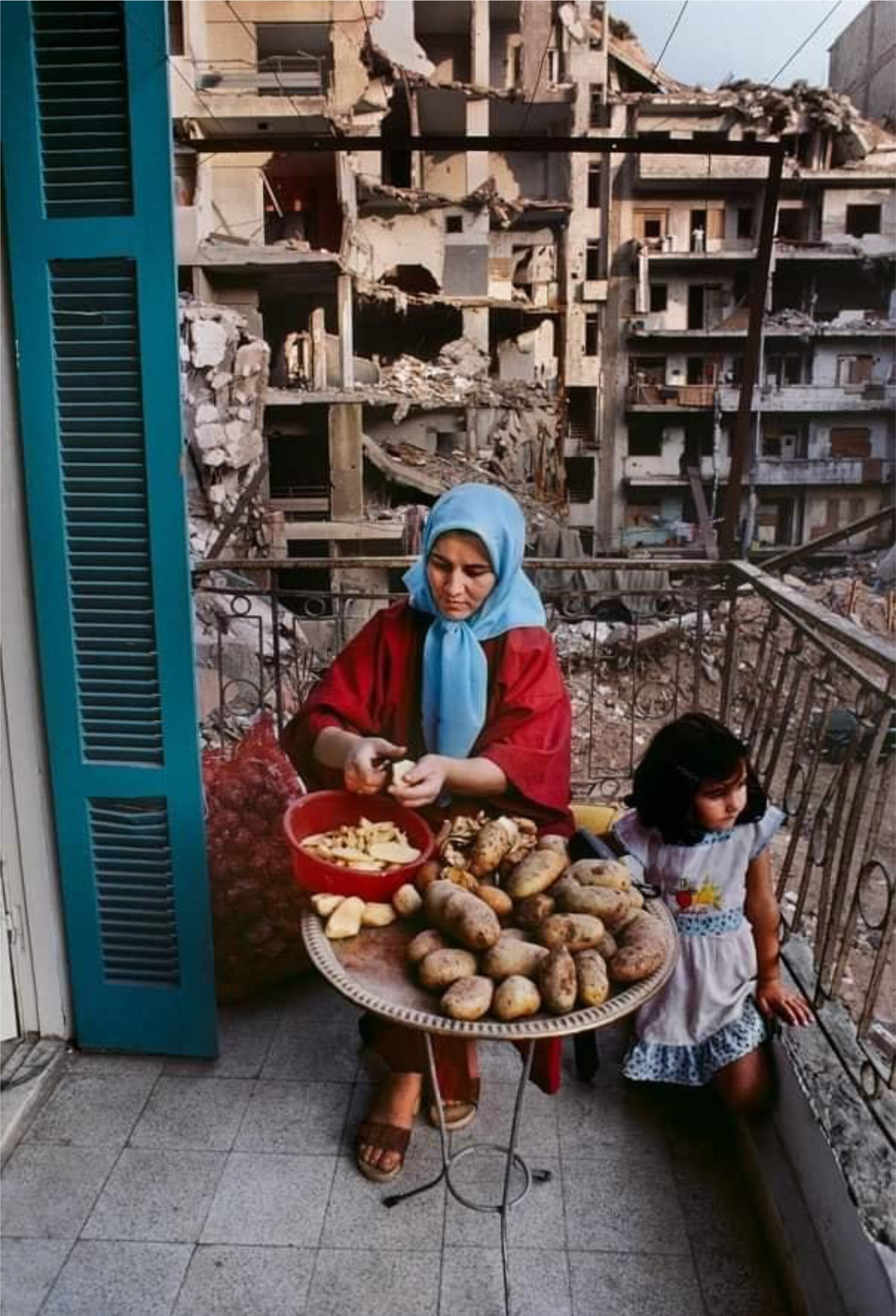
Fleeting realities or not, that brief exchange registered truths grounded in that particular moment and place, ones that necessarily sift through to present-day Beirut. Such marginal experiences, if we care to trace their evolution and significance, uniquely intertwine and illuminate the political and cultural histories of Lebanon and the region. To travel anywhere, even within a city, and to see at all, requires an outsider’s, though not necessarily a foreigner’s, perspective–one that is displaced by time, or place, or by a fragmented sense of belonging. And this way of seeing can be cultivated. My memory of that moment on the Corniche is of course set in sharp relief against other moments on the same Corniche that took place before and after it, and against layered experiences of the city’s other legendary, cosmopolitan streets, like Hamra.
Back for another visit ten years later, I was with my five-year old daughter in a service taxi rambling down Hamra Street. I inquired about a large Rifai store with pristine, bright displays that had been located on Hamra. I explained to the driver that it had been there the year before the civil war when I lived in the neighborhood. The driver told me blandly that it was gone. I asked where then I might find some men wa salwa? He frowned at me quizzically in the rearview mirror and asked, “what is el-men wa salwa?” “You know,” I replied smiling, “the floury nougat with cardamom that we can eat in paradise.” He jerked his back straight and paused, eyes wide in feigned disbelief. His confusion cleared, he turned to me comically, waved an arm upward, exclaiming, “wlo ma mnistahel hal men wa salwa!” (Really, we don’t deserve this men wa salwa!) I laughed in appreciation of his wit, and thanked him as I drew my little girl out of the taxi. We made our way to Modca Café where we had coffee and ice cream on the sidewalk terrace and watched the people go by.
While sitting in the same spot with my family in 1974 before the war, and while, probably for the twentieth time, eating chocolat mou with my brother, a group of tanned streakers, men and women, jogged by in gym shoes, sunglasses, colorful sunhats, and nothing else. My brother and I were, of course, fascinated and excited, my parents charmed. We were to have several other streaker sightings in Hamra and along the Corniche. However improbable, streaking in Beirut was just one subject of jaunty conversation that year. It was internationally fashionable (and has since, apparently, become an eccentric practice relegated to British sporting tournaments). So incongruous was this sight in the context of Beirut’s cultural groundings and subsequent history, that today we might have wondered if we had really seen these local streakers at all, had we not witnessed and talked about them collectively.
Beirut experiences, then and now, often involve witnessing or living through events so improbable that we are forced to question what is engraved in our memories, quite aside from unusual sightings. We Beirutis necessarily sustain visions inspired by defeat, destruction, reconstruction, and longing. The frenetic and noisy transformation of Beirut, from war, displacement and, above all else, demolition for the sake of (haphazard) rebuilding, lends a mirage quality to daily life here. And this, in turn, can make us more aware of possibilities for transformation in our own thinking, sensibilities, work, and lives both individual and collective. The energy, incoherence, and surprise of Beirut are, at times, both nightmarish and visionary, sad and exhilarating.
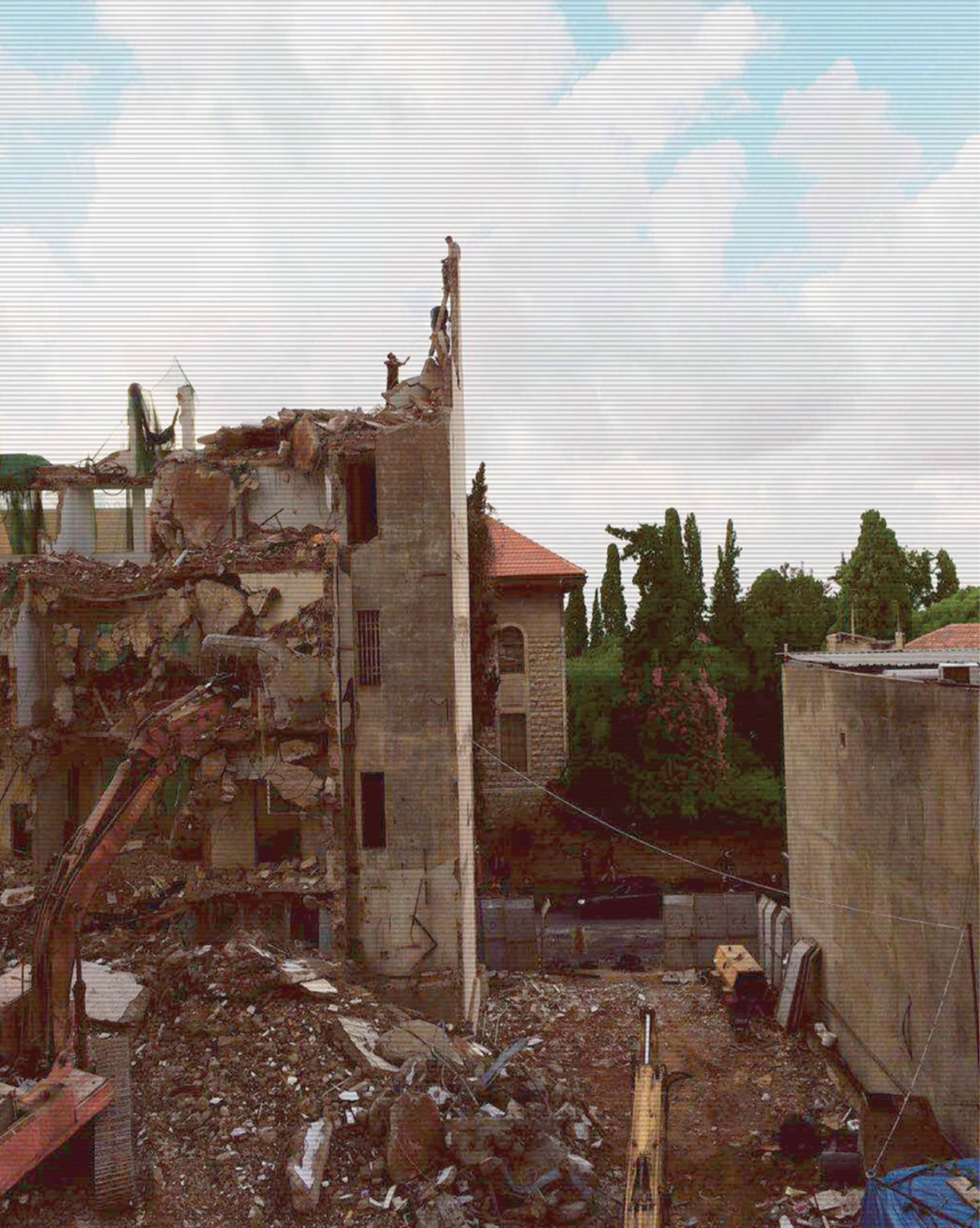
Before moving to Beirut again in 2010, I had already met with unauthorized urban transformation. This I encountered vividly at the moment of arrival in Ramallah after a very long absence. After graduating from college in Palestine, I had returned to the USA to continue my studies, after which I started my first job. During this time, Israel’s separations had severely altered my town. In the periods when I grew up there, Ramallah was composed, fresh and lovely, open to Jerusalem, built on low mountain tops covered with trees and stone houses with red-tile roofs like the ones we still find in the Lebanese mountains and the Bekaa. This time, fourteen years after I had last been in Ramallah, when I got out of the service taxi in front of the bus station and turned to face the Manara, I saw Kerala. And I liked it, actually, as it reminded me of vibrant and colorful towns I had visited. Ramallah had seemed to gain in energy and interest from the many villages that had spilled into it. But the experience was also troubling and unfair, as if I was returning home after one hundred years. In my disorientation, I searched through the pageantry in which I found myself, through the banners crisscrossing the streets advertising snickers bars and phone companies, until I spied traces of the Ramallah familiar to me. I understand the brilliance of Mourid Barghouti’s seemingly childlike book title I saw Ramallah. Beirut’s daily life is also lived in the grip of this kind of urban irony.
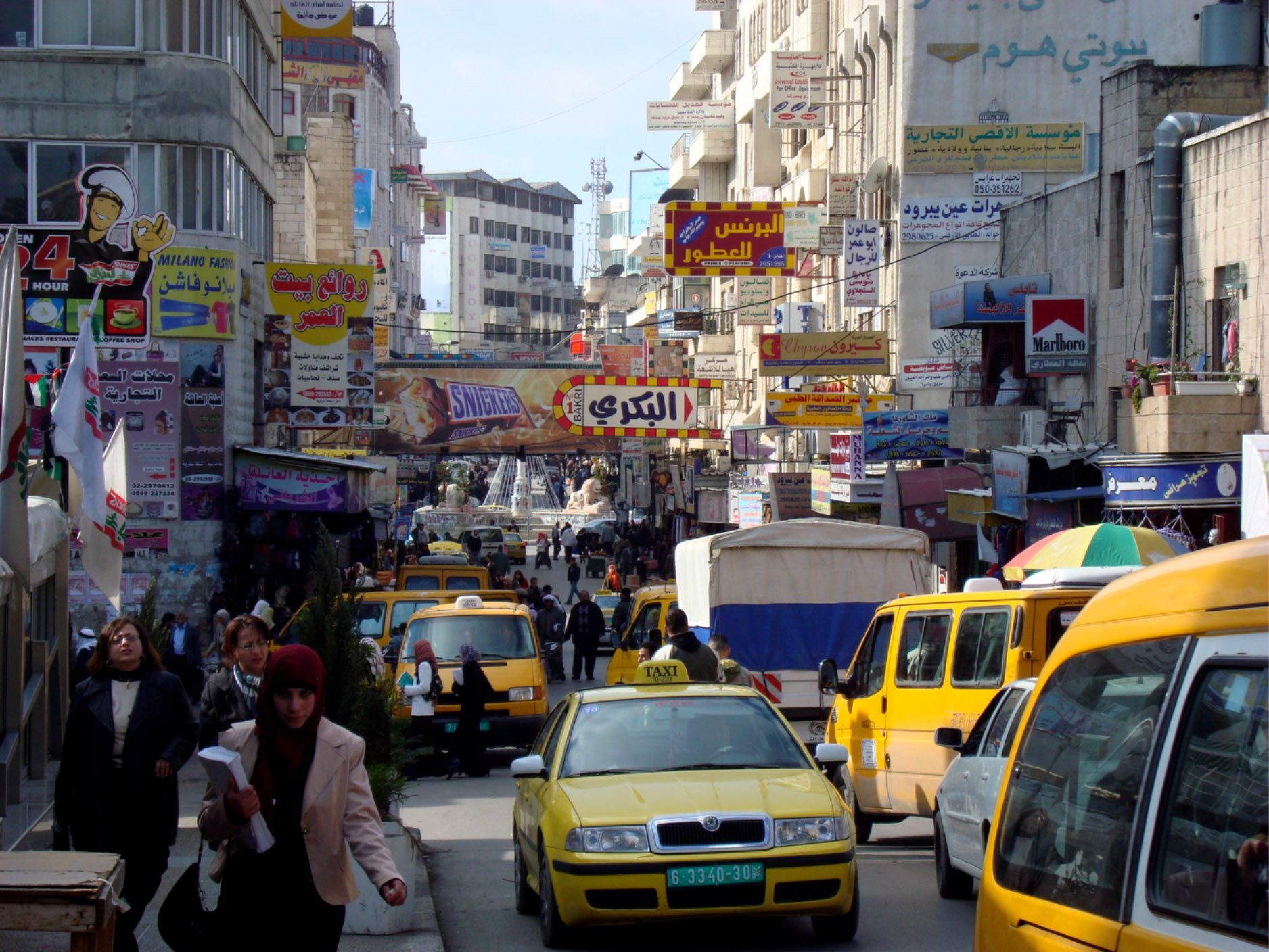
Places and experiences quickly vanish in Beirut, at least in part, because of continuing, often unintelligible, and always accelerated transformation. Urban spaces are constantly made-over, built anew at micro-levels, with new buildings and their smart sidewalks that extend only out front—at the edges, there are broken, obstructed sidewalks or none at all. Air is regulated against heat and smell in the little interiors of aggressively high, fat, four-wheel drives. And we also find a single balcony painted a striking shade of brick against a discolored facade, drawing the eye to the flowering plants that adorn its railings, making us dream. Many pockets and vistas are breathtaking in this way, not despite, but because of such contrasts. The more hidden are the experiences and corners of this city, the more fleeting and telescoped and visceral, the more they bespeak Beirut.
Beirut exists, in fact, in pieces, impossible to grasp in a single view or in one fluid experience. Moving through another kind of city with proper urban planning and no recent wars can be so coherent it feels like a postcard, and at times paradoxically disquieting. But in Beirut we are there, physically and sensorially part of its kaleidoscope. We can travel to surprise destinations just down the street or in the next neighborhood in this funky, head-turning town. This city historically offered a haven and a measure of freedom for artists, intellectuals, exiles of every order. And when we walk through the streets of Beirut, our beloved places and lost homelands move with us.
*An earlier version of the section “Hometowns” was previously published in Beirut Guide for Beirutis, Ed. Jenine Abboushi, Dar Al-Adab, 2017.
Thawra
I traveled from France to Beirut to visit on October 18, 2019, a day after the start of the revolution. We did not yet know that the protests would quickly become a mass revolution. And until that morning it was not even clear if I could enter Lebanon. I had been in touch with friends to see if Beirut Airport would be open, whether we could leave the airport once there, or even walk out with a small carry-on. I heard about the scooter drivers charging up to 120 dollars to deliver travelers to the city, and others were transporting people in solidarity. My plane ticket got cancelled. For some reason determined to get to Beirut, I found another with Turkish Airlines. I missed my connection (I could not walk-jog in time to my gate at the other end of the vast shopping mall that is the new airport of Istanbul), and on the next flight I arrived in the early morning the following day.
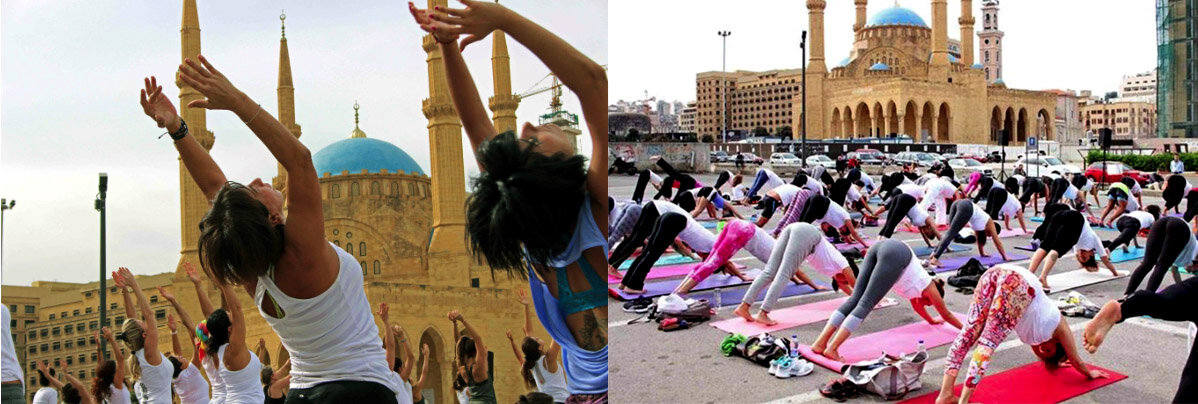
Beirut airport seemed barely in service, and there was no transportation at all when I emerged from the building. I had a random idea and called Uber, and almost immediately a car pulled up. The driver thanked me profusely, saying he had been in the parking lot for hours, as no one knows they are working. Upon arrival I assume this agile Beiruti mode, ready to adopt methods from innovative to “normal” as needed, to travel behind scooter chauffeurs, luggage balanced on my lap, or call an Uber—which was incongruous in this context. I thought of my last day in Beirut before moving to France, when I hosted an enormous brunch for all my friends. Several in the kitchen watched me at the stove cook up another giant tortilla while rocking, with one foot, the near-empty Butagaz that I had quickly laid on its side, trying to use the last of the gas to make more tea. “How will you ever adapt to a normal place?” they asked me, all of us giggling. “I cannot entirely. But who would want to? That’s dependency, getting put on hold for hours!”
To be sure, this acrobatic way of life many Beirutis learn is a gift from life lived well in this city. I also learned this kind of competence in similar cities where I had lived, like Casablanca. Few can compare with the master engineers of Derb Ghalaf market who confect handy sculptures with electronics and appliances. One gets the impression that they are capable of cabling a generator to an old refrigerator and unidentifiable metal scraps and gadgets and, with a cell phone command, launching a rocket over the Straits of Gibraltar. This willingness to find ways to put things together, take provisional measures, is everywhere apparent in Lebanon. And this kind of intervention and accommodation affords a rare sense of belonging between people living in shared spaces. Long-suffering from from incessant large-scale security fallouts over the years, on a human level, we sustain a sense of safety and warmth by spontaneous practices of solidarity.
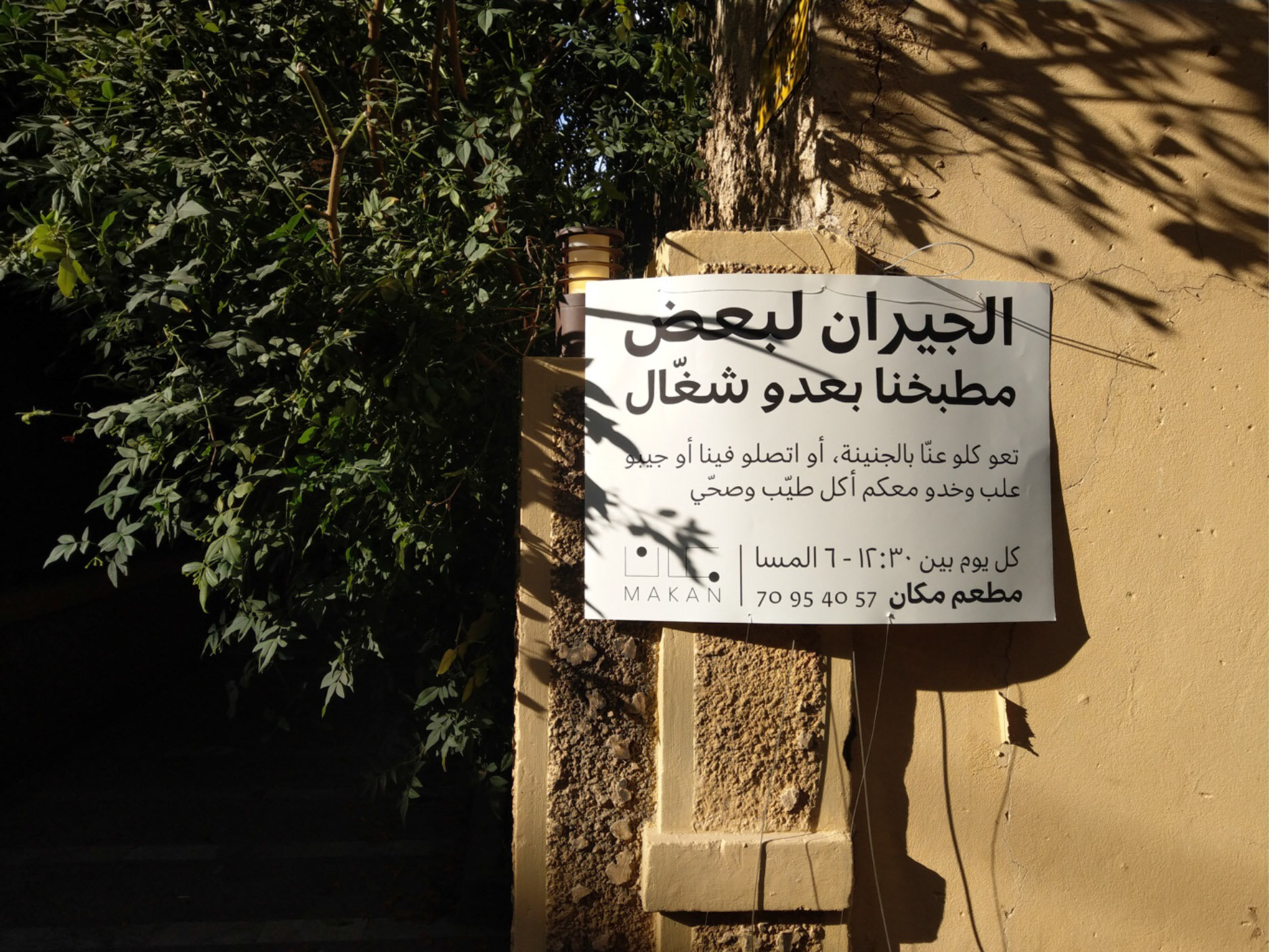
We drove out of the airport and tried to head up the mountain so I could visit a dear, ancient friend who was ta3baneh, tired, as she said to me in a small voice when we last spoke, but the driver encountered one burning tire barricade after another. Thinly manned in the early morning, we still did want to cross their efforts, so I asked the driver to take me instead to a friend’s house in Baabda. By mid-morning in her household, it was time for “thawra,” revolution, which included, in those early weeks, aunts, uncles, neighbors, young children, baby-strollers—whole families and groups of colleagues and friends. As the extended family mobilized to leave in several cars, arranging to pick up people on the way, my friend’s niece prompted her fiancé by phone, “thawra, chérie?” They make a radically mixed couple religiously, and in terms of social class, which is common in Lebanon, and a historical reality often refuted socially. From the first day of the revolution, they both became organizers. In the coming days, they took in logistical ideas as they helped organize a human chain, extending from Tripoli in the North to Tyre in the South, and which was to take place a week later. This chain would introduce, on new terms, many discrete Lebanese communities to one another, thus partly undermining sectarian divides.
Everyone who wanted to work for the revolution could enter the operations room, it seemed. And this revolution’s artisanal practices, imagining and trying out new ideas and methods, borrowing from and lending to simultaneous revolutions from Algeria to Chile, Iraq, and Hong Kong, was exhilarating, so clearly empowering for new generations in particular. The sunset drumroll of wooden spoons on pans, played by people from their windows and balconies, still rings in our ears.
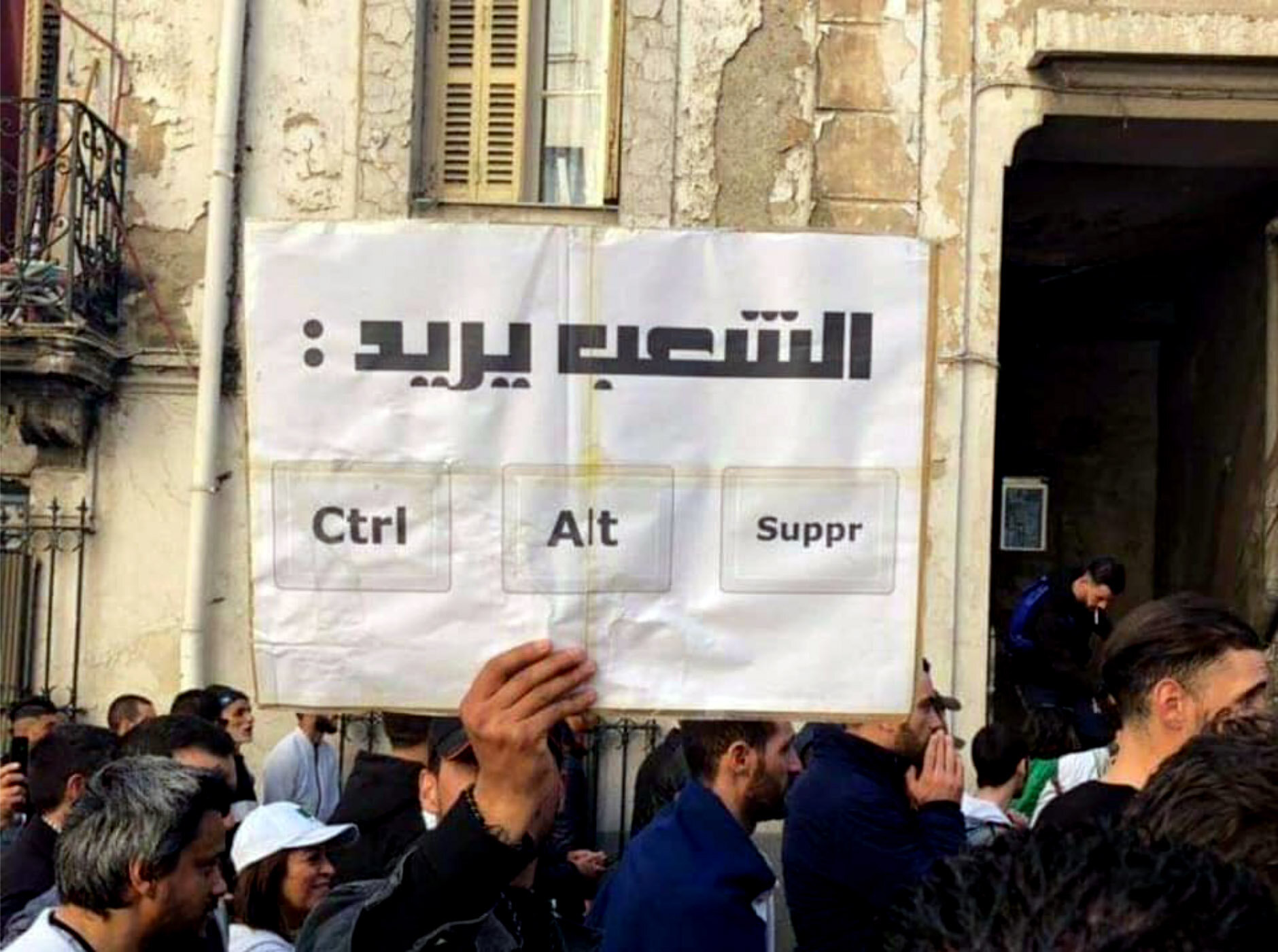
At one point that day on Sahat Al-Shuhada, Martyrs’ Square, we stood still, breathing, as we could not un-meld ourselves from other bodies. One gunshot or any attack (from the army, or people from Amal and Hizballah sent to beat demonstrators—which started a few days later), and we would all be accidently stampeded by one another, we realized, wide-eyed. We learned later that one-fifth of the population of Lebanon was in the street that afternoon, demanding “kellon ya3ne kellon” (ALL of them, and that means ALL) of the political class, all the warlords in power—most recycled from civil war days—to get out for good. This became the enduring slogan of the revolution. Many demanded a new constitution, a secular state, an end to sectarian rule which has long enabled and thrived on corruption. These ideas are gaining force and popularity.
A new awakening against sectarian corruption commenced a few years preceding the outbreak of the revolution, with daily life surrounded by mountains of uncollected garbage. This dramatic sanitary crisis inspired mass protests, which clearly served as initial training for the younger generations especially, leading to this revolution. And in 2019, Algeria certainly showed us the way: the Hirak, a mass, peaceful revolution (arguably the most disciplined in modern history) practiced by a people who have long been ruled by corrupt leaders who use blackmail, just like the political class in Lebanon: either consent to corrupt, thieving politicians and ensuing poverty (and in the case of Algeria, its natural resources are pirated by multinationals for decades to come), or the country will suffer a new round of terrifying, heart-wrenching civil war. This threat grew less compelling, and Algeria opened up for Lebanon and the world a third way, through peaceful, mass protest. It is worth pausing on the magnitude of the Algerian and Lebanese 2019 revolutions. And yet world media coverage of both was scant.
That day on Martyrs’ Square we followed other demonstrators up the broken staircases, open to the sky, of the Egg—a dilapidated cinema on Martyrs’ Square, a strange-looking edifice suggesting an interplanetary landing in the 1960s. On our way to the giant Egg, we waved to protesters sitting across the top of a billboard, legs dangling over the image, while others descended the shell of the Egg by rope, hoisting a Lebanese flag. Spectacles and signs all over were hilarious, inventive, liberating. In the days to come, protesters transformed the Egg into a public gathering headquarters, where teach-ins and other events would be held by the revolution.
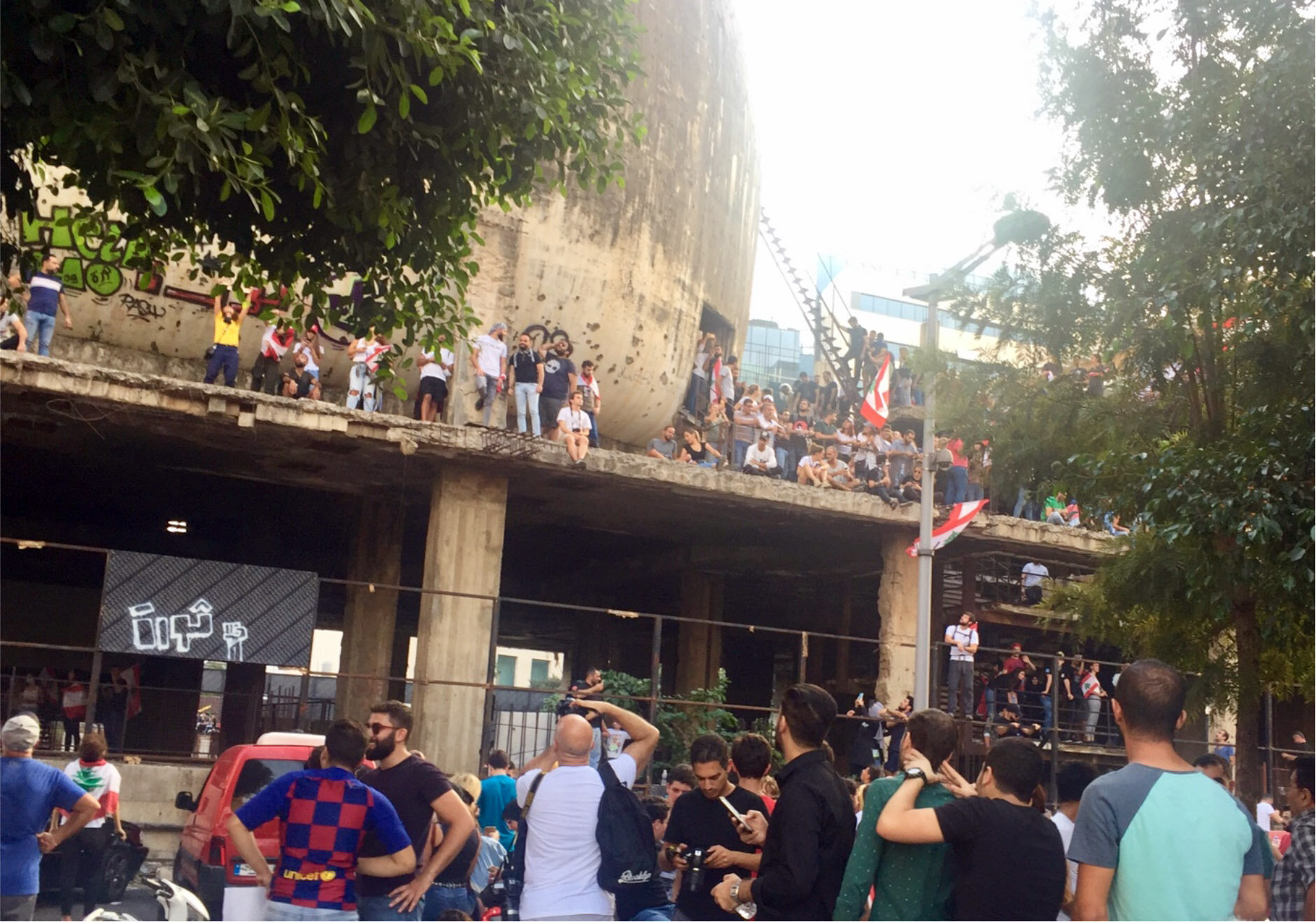
It is a magical privilege during protests to take over buildings and spaces denied to the public, and to repurpose them for the revolution and civil society. This was easy for Beirutis to do. Both bold and accommodating, they forge a level of freedom in daily civic life unthinkable in much of Europe, bending rules as they navigate their way (usually politely requesting passage or forbearance, sometimes abruptly imposing their will), which can be charming or exasperating. Even before the revolution, we live in a formal anarchy—here meaning a country that either has no government at all or a radically ineffective one. My big surprise when I arrived again to live in Lebanon was how well anarchy worked on some levels.
The beginnings of most mass, peaceful revolutions are carnivalesque, where everyone transforms, training in new roles. By late afternoon on Martyrs’ Square I received a call from a friend, a Pakistani British writer who teaches at AUB: “Are you there?” “I’m here, but whereabouts are you?” I ask him. “Did you see the Botox Brigades?” He quips, “I couldn’t take it, so I left.” We laugh through the surrounding din, and I answer, “I did, actually. Or I saw one battalion passing Falafel Sahyoun (Zion in English, a Lebanese family) where we got ourselves refueled. But take this as a good sign! This revolution includes ‘ALL of us, and we mean ALL,'” I tease, playing on the revolution’s slogan. “Aah,” he puffed as we hang up, laughing some more.
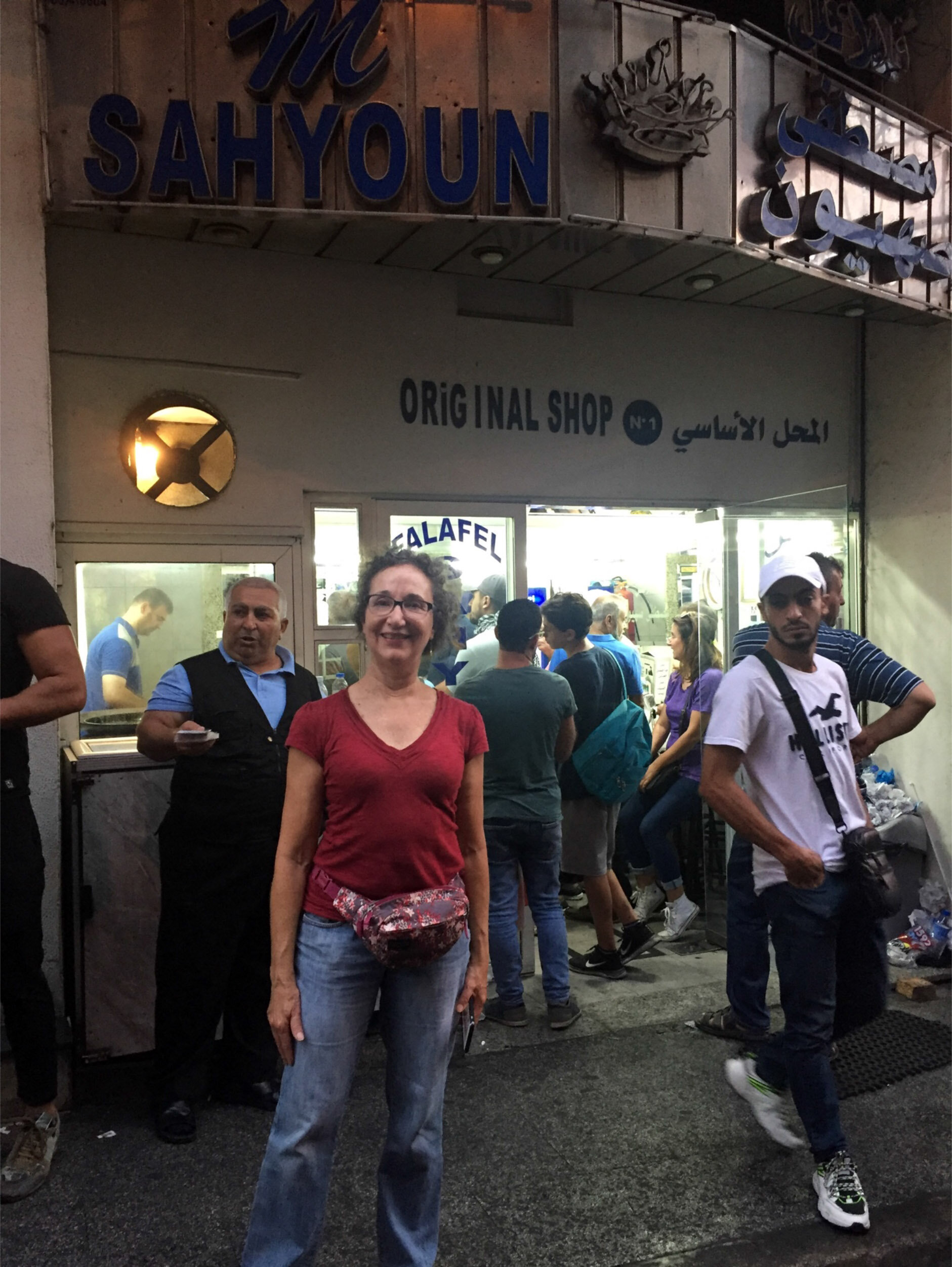
The next morning, the Syrian fellows running the tiny mana’eesh place on Makdisi street in Hamra, who from 7 am onwards sell their zaatar and olive oil pies over a counter, served hot from the oven just behind—something between a push cart and a storefront—were not taking this “bourgeois” Beirut protest crowd too seriously yet. They showed me videos of dancing babes from the night before, one wearing a sequined, tasseled bikini, and asked me to tell them if this is a revolution? “I think it may be,’ I answer, “and perhaps we will soon find out in how many ways. Let’s see.” Like him, I did wonder about the stages set up by evening with loud microphones and mini-concerts in revolution square, arguilehs(hookah) for rent, and older men and women, families, relaxing in white plastic or folding chairs. But simultaneously, young people were setting up specialized tents (offering psychological assistance, for example), preparing for the next day. These same troupes arrived downtown early in the day for many weeks to clean the streets.
We were not sure of the extent of these protests until we saw on our screens the rest of Lebanon and especially Tripoli in revolt—the epicenter of the revolution—now cut off from Beirut and videotaped by participants (the real news source from Lebanon to Palestine and Algeria). From the beginning in Tripoli and Beirut, and in many towns all over Lebanon, young women took leadership positions, became spokespersons, and the videos of their chanting circulated the world. One young woman in Martyrs’ Square, who looked like a university student, chanted off a list of political leaders’ names, and the crowd hollered back “BARAH” (out!) after each name: “Samir Gaga3 (‘BARAH!’), Michael Aoun (‘BARAH!’), Hasan Nasrallah (‘BARAH!’) …” In surprise and fear for her, we admired her bravery and prayed for her safety. Soon this breaking of political taboos was widespread, fearless, with comical, inventive chanting and placards. In Tripoli, one hard-hitting teenage girl wearing a headscarf, leading a crowd with a microphone and a raspy voice, full of charisma, breaks suddenly into a beautiful smile. She looks right out of Palestine, full of grit and stamina from a hard life you can see she carries. Through my overlaying transparencies of memory and longing, all of downtown Tripoli looked like it was in revolt against Israeli occupation forces. Predictions that the Israelis were about to bomb Lebanon changed, assuming they would delay, not wanting an unclear outcome if triangulating with the war in Syria and revolution in Lebanon. The revolution felt suspended in history, a way open to push forward and create new realities.
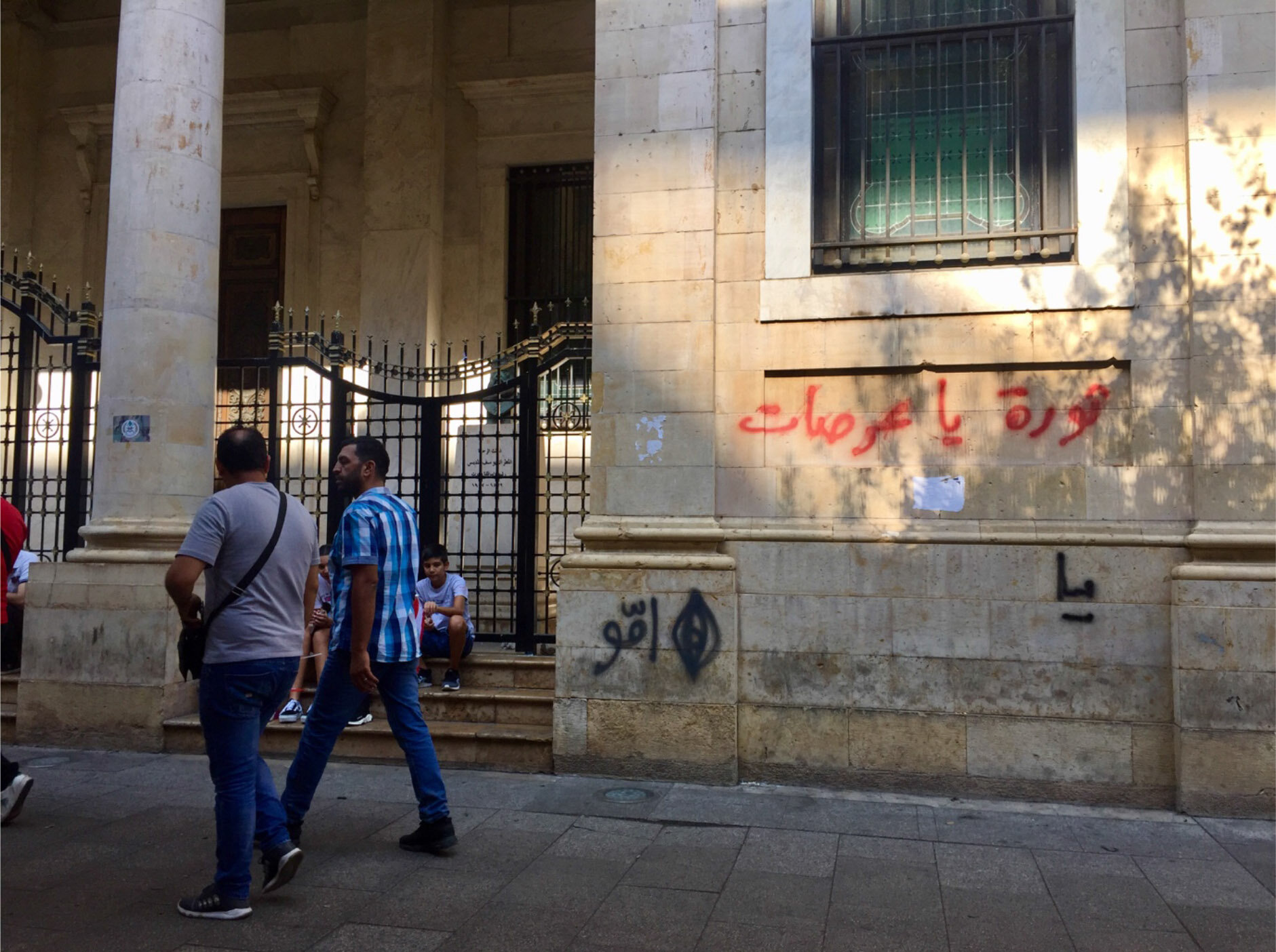
I also spent time walking away from Martyrs’ Square. The meanings and limits of the revolution could be discovered as much in the margins and quieter hours of the day as in Martyrs’ Square. Around Hamra in the very early morning and along the coast near “Corniche el-Daraweesh*,” Ramlat el-Bayda (the tiny strip left of sand beach inhabited mostly by the poor and refugees these days), evaporate as marginal spaces by 8 am in Hamra, and in Ramlet el-Bayda outside of upheavals. Both areas I found uncannily empty. Walking in the translucent Mediterranean light, I halted in front of Ajial Art Gallery at 63 Abdel Aziz street in Hamra when I saw two homeless teenage boys, probably Syrian refugees, perhaps brothers, cousins, friends, or lovers, sleeping on their stomachs over a flattened cardboard box. A living tableau, poignant, beautiful, forgotten. The last time I entered Ajial was during the “Divine Comedy” opening of Chaza Charafeddine’s work, inspired by the region’s popular culture, early Islamic art and mythology. I recognized her tall, beautiful, cross-dressing and transgender models making their way down Abdel Aziz street as I was arriving, and mingling with the crowd inside. Charafeddine casts these models in her collages as regal buraq, half-horse, half-human, and the name of the horse upon which the prophet Mohammad ascended to paradise from the Dome of the Rock in Jerusalem.
* “Corniche Al-Darawish” (a common appellation) is mentioned in “Corniche Frontiers,” Rania Afiouni Monla, in Beirut Guide for Beirutis, Ed. Jenine Abboushi, Dar Al-Adab, 2017.
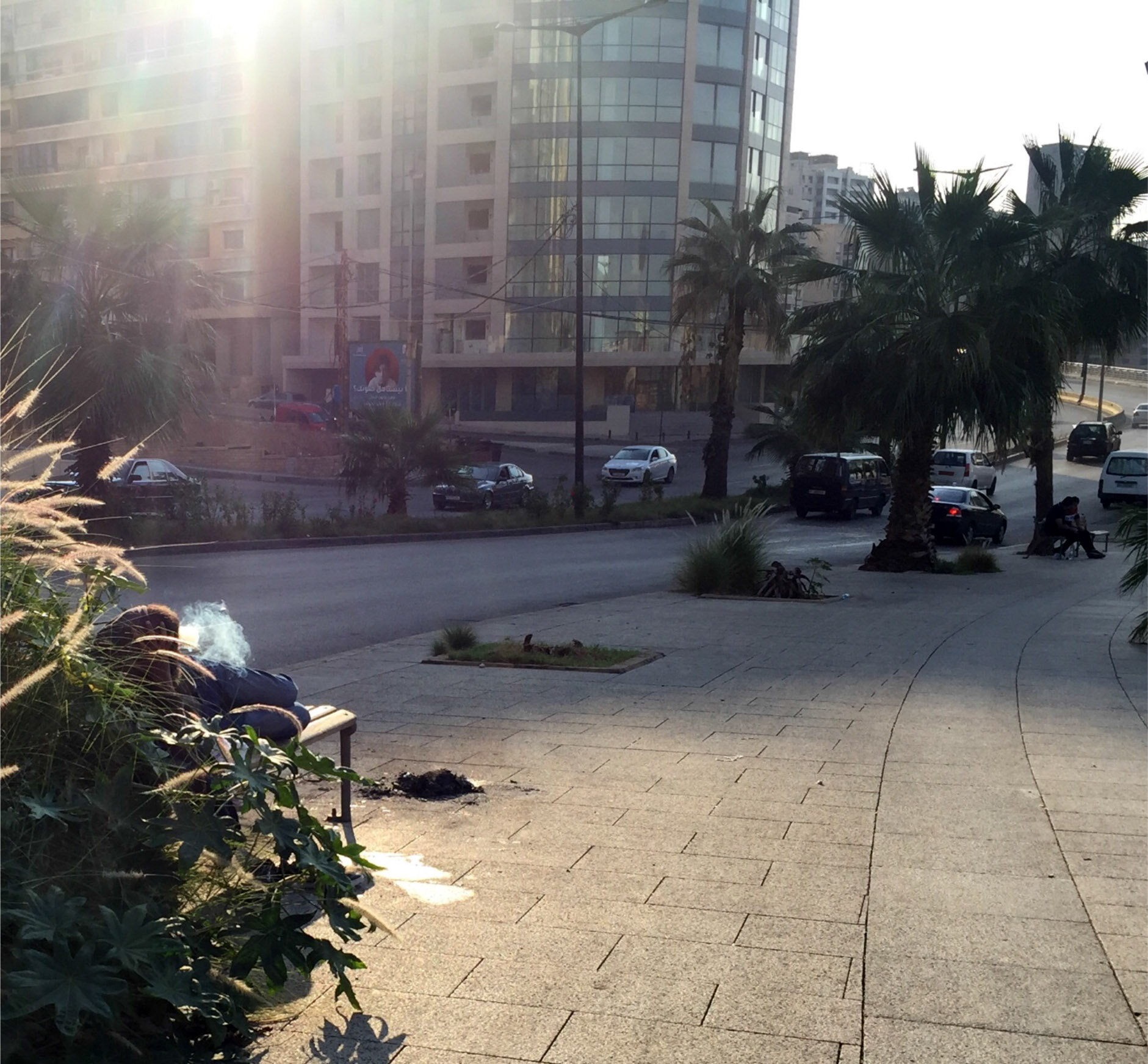
On the Corniche at sunset just before the descent to Ramlet El-Baida was a lone homeless man lounging on a public bench, puffing inscrutable smoke clouds like the caterpillar in Alice in Wonderland. I caught his eye softly watching the Mediterranean Sea, still framed all along the Corniche by a surprising amount of grassy, untenanted land (not yet confiscated for development), dark rocky cliffs, or bedrock plateaus used by fishermen. His pastime is age-old, shared by Beirutis then and now–refugees, indentured servants, social outcasts included. Perhaps the most passionate landmarks for all with a sense of belonging to Beirut are just along the Corniche shore—there’s Pigeon Rock of course, but we often seek out less spectacular, personal monuments of sorts, among the smaller bedrock formations in Beirut’s waters that ground our sense of belonging, remind us of moments passed, secret and meaningful, in this incomparable place. We cannot entirely count on, for historical reassurance, the buildings and urban spaces of Beirut, ephemeral and transforming to a violent degree. But we can trace and root ourselves along Lebanon’s coastal bedrocks, unique in all the world.
Important parts of this ancient urban shoreline have been cemented, effacing references to histories—personal, regional, and civilizational. Some such projects were breathtakingly rapid in their destruction. Pompous constructions of the past, like Alexander the Great’s Causeway in Tyre [cf. Marriner, Nick. Geoarchaeology of Phoenicians’ Buried Harbours: Beirut, Sidon, and Tyre. 5000 Years of Human-Environmental Interactions, Aix-Marseille, 2007], do not compare to the destruction visited by latter-day warlords, like Randa Berri’s (Amal leader Nabih Berri’s wife) confiscation of part of Ramlet El-Bayda to erect her absurd resort hotel, Eden Bay. A much larger disaster is of course Hariri’s Solidaire project (an ironic name, as the rightful owners of downtown property were essentially robbed, their property undervalued, offered meagre compensation, if any). The Hariri project created what archeologists darkly called “the largest archeological dig in the world,” crassly destroying national and world heritage sites, and—most frighteningly for a society emerging from civil war—effacing the features of urban landmarks that provide us all with a sense of belonging and dignity, both collective and individual. I remember my own unease, even fear, when I learned the of scale of destruction planned by the Hariri project during the summer of 1990 when I was in Beirut.
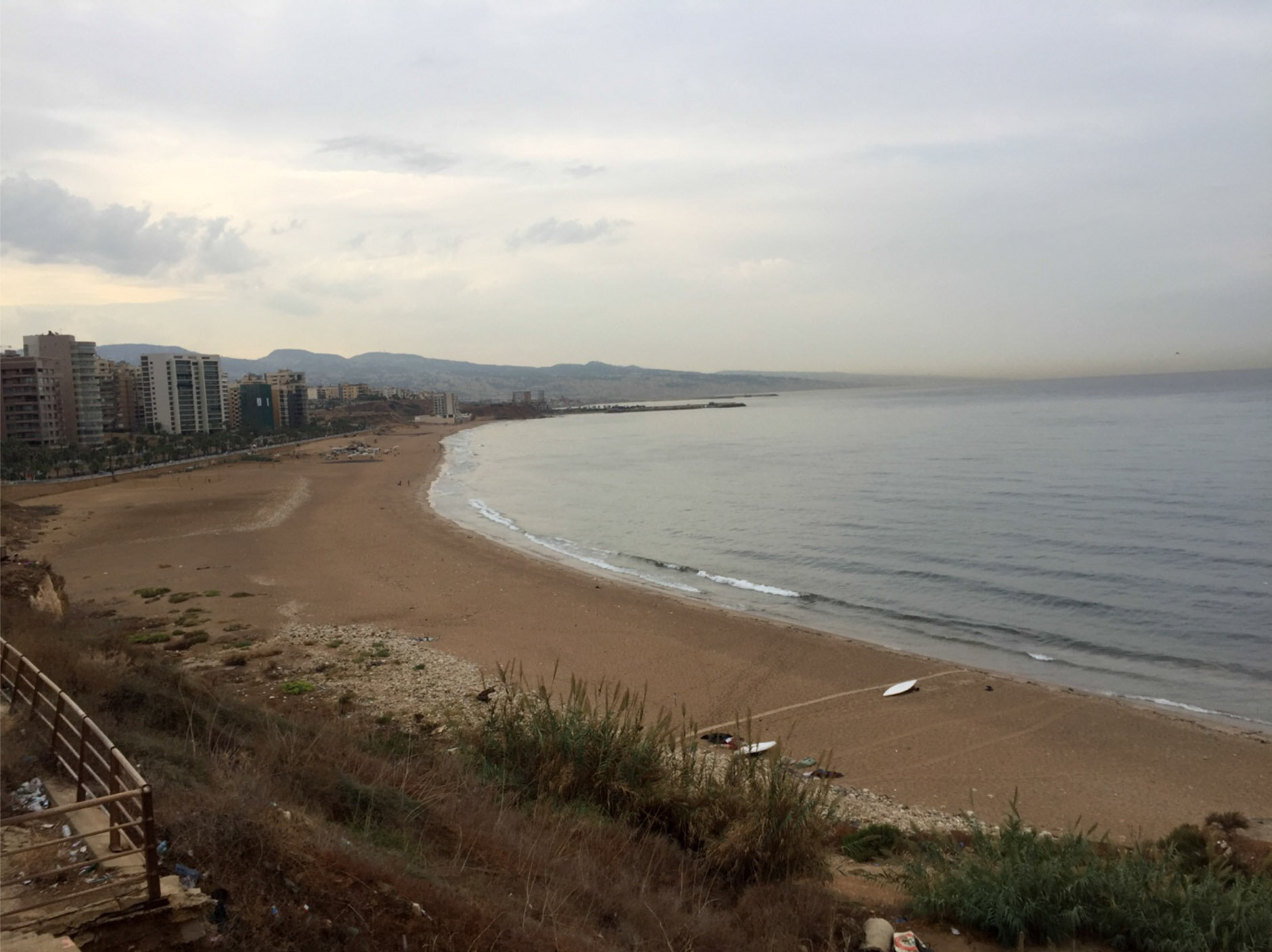
With a small camera I headed downtown and took several rolls of film around Martyrs’ Square, El- Burj, and the magical Aswaq that I loved as a child living in Beirut on the eve of the civil war. I do not know what I will do with these photos besides continue to store them with personal letters in a trunk. But in these photos, I can still see where my father’s cousin Maha took me into a sleepwear boutique, and asked me to choose a nightgown from the beautiful, pinned-up garment display covering the ceiling and walls. Behind a long counter atop a vitrine, a matronly saleswoman spread out several nightgowns in my size with a masterly snap of the wrist and wave of the material. I chose a pretty ivory cotton one, with small pink and red flowers and an undulating trim, and hugged my aunt’s waist.
These particular streets and buildings and stores—the material traces that sustain memory, each of our life histories, in psycho-emotional detail, are foundational. In any city, new buildings replace old ones inevitably. But not all of them, and this transformation does not normally happen at such a pace or scale (and Berri and Hariri are two out of many bosses responsible for lots of destruction and ugliness in Lebanon). Nor is it common to cause the annihilation of material culture, like the Aswan High Dam that submerged the lands of Namibian nomadic peoples and Egyptian fellahin, and like the explosion on August 4, 2020 that has devastated Beirut’s ancient seaport and surrounding neighborhoods, killing and maiming so many. In these heart-rending cases, healing and rebuilding can only be partial.
It is the specificity of our historical material culture that structures our sense of identity, empathy, and purpose, which we transmit to new generations. Not just any bright buildings or streets will do, as it is equally unmooring to live in the equivalent of hotels, magazine-perfect apartments devoid of objects of personal and collective memory. Beirut’s downtown was heavily damaged during the civil war, but not enough to warrant the level of destruction authorized by Hariri’s Solidaire. Many thought this project would restructure and build anew, help put the horrors of the civil war and Israeli invasions and occupations behind them and boost the economy. Indeed, money and power can do little without a combination of widespread apathy and consent.
Beirut Forever
Popular consent to the sectarian system, even complicity with Lebanon’s warlords, now political leaders, may be partly understandable following the civil war—letting sleeping dragons lie. But of course, this unspoken détente allowed the ruling elite to rob and run international rackets—until soaring levels of corruption caught up with this tiny country, and its synthetic economy imploded. It was to happen with or without the revolution.
The government’s pandemic lockdown, starting in the Spring of 2020, dampened the revolution, but the people relaunched the protests with a vengeance after the explosion, meeting more army repression, and pulling down the government but not the sectarian system. During the lull in the revolution, all were preoccupied with the trials of daily life even more than the pandemic, with finding provisions and food with meagre means, increasing unemployed, and prevented from withdrawing their own money from their bank accounts. A large part of the middle class has slipped below the threshold of poverty, and increasing numbers of the poor and refugees are going hungry, especially in Tripoli and the North. Meanwhile, the corrupt elite has escaped beyond the borders with the country’s dollars, pushing Lebanon further into bankruptcy and destitution.
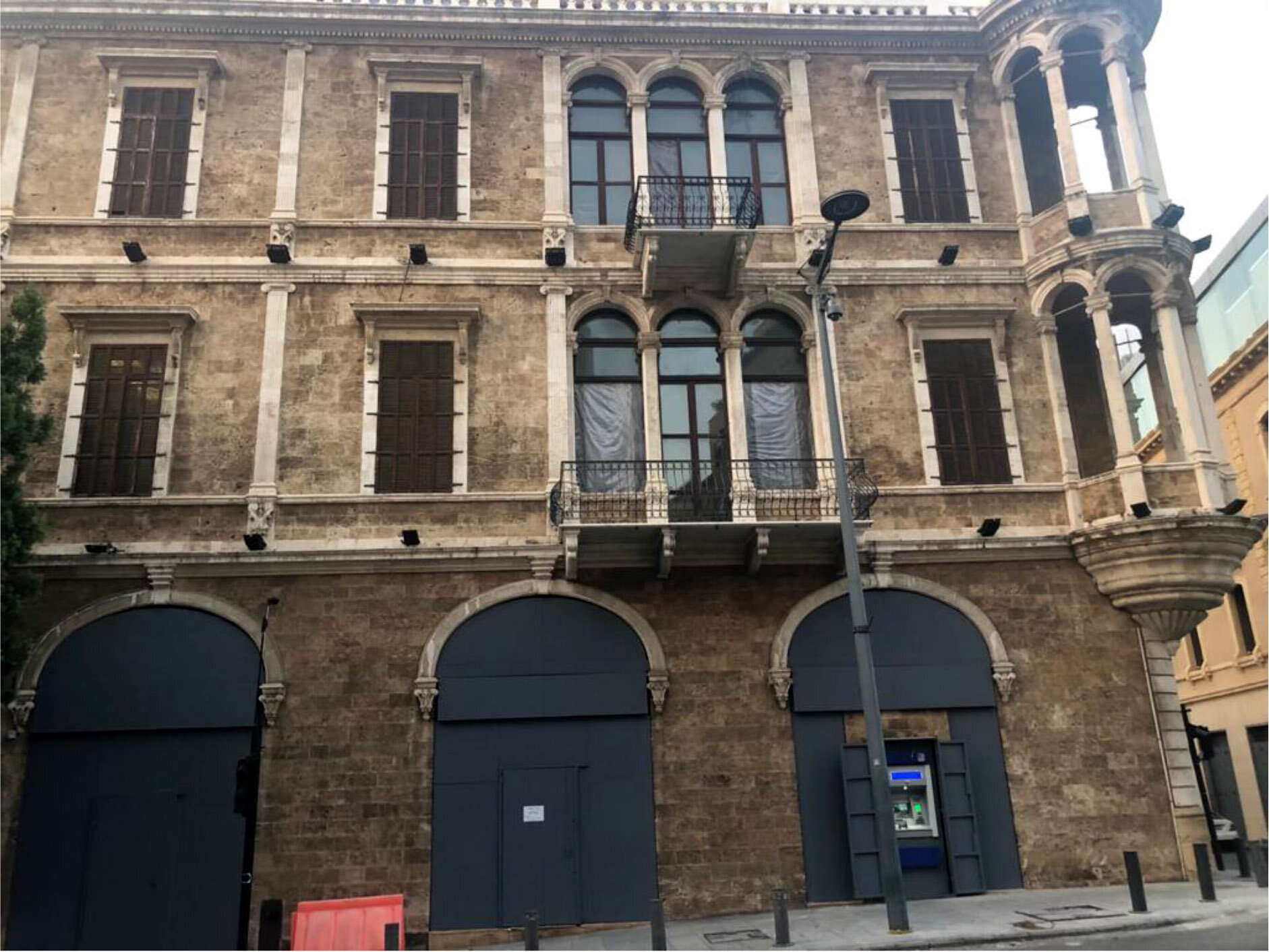
The cataclysms of 2020 in Lebanon and globally have arrested metaphoric language. (May it soon be set free, and I now post more poetry on social media.) So “banks turned into fortresses” in Beirut is not an image. Men at work covered Bank Audi downtown with high metal shields, turning it into a giant hockey puck with writing on it, or an industrial vacuum cleaner that siphons the people’s dollars off to the foreign bank accounts of the rich and powerful. (Many luxury stores and most of the banks are likewise barricaded, like they had been, people remember with apprehension, before the civil war.) When I entered the café in Marseille where I am now sitting, and inquired about its change of name, the manager explained that the roof caved in on one of the owner’s businesses, and he decided to revamp and rename his two remaining cafés. Despite the lockdown recession in France, I naturally assumed she refers not metaphorically to yet another business closing down, but quite literally to a physical disaster (and indeed it was). And when we heard that Beirut’s center exploded, we knew this was not a metaphoric reference to the revolution picking up.
Since its onset, the Lebanese revolution is demanding full democracy. There was a massive, candle-lit demonstration in support of women’s rights, smaller demonstrations for Syrian and Palestinian refugees’ rights, and more marginal still were protests in support of foreign indentured workers’ rights in Lebanon. The current demand for structural change, a new constitution and a secular state, has gained considerable force, but we must recognize what sectors of society could fully dismantle sectarianism. This would be the new generations that, following the Beirut Port explosion, flowed in from all over Beirut and Lebanon. These goodwill troupes arrived directly to repair homes, clean debris, cook for people who need meals, forming a grass-roots, collective leadership. No government officials or relief-services showed up.
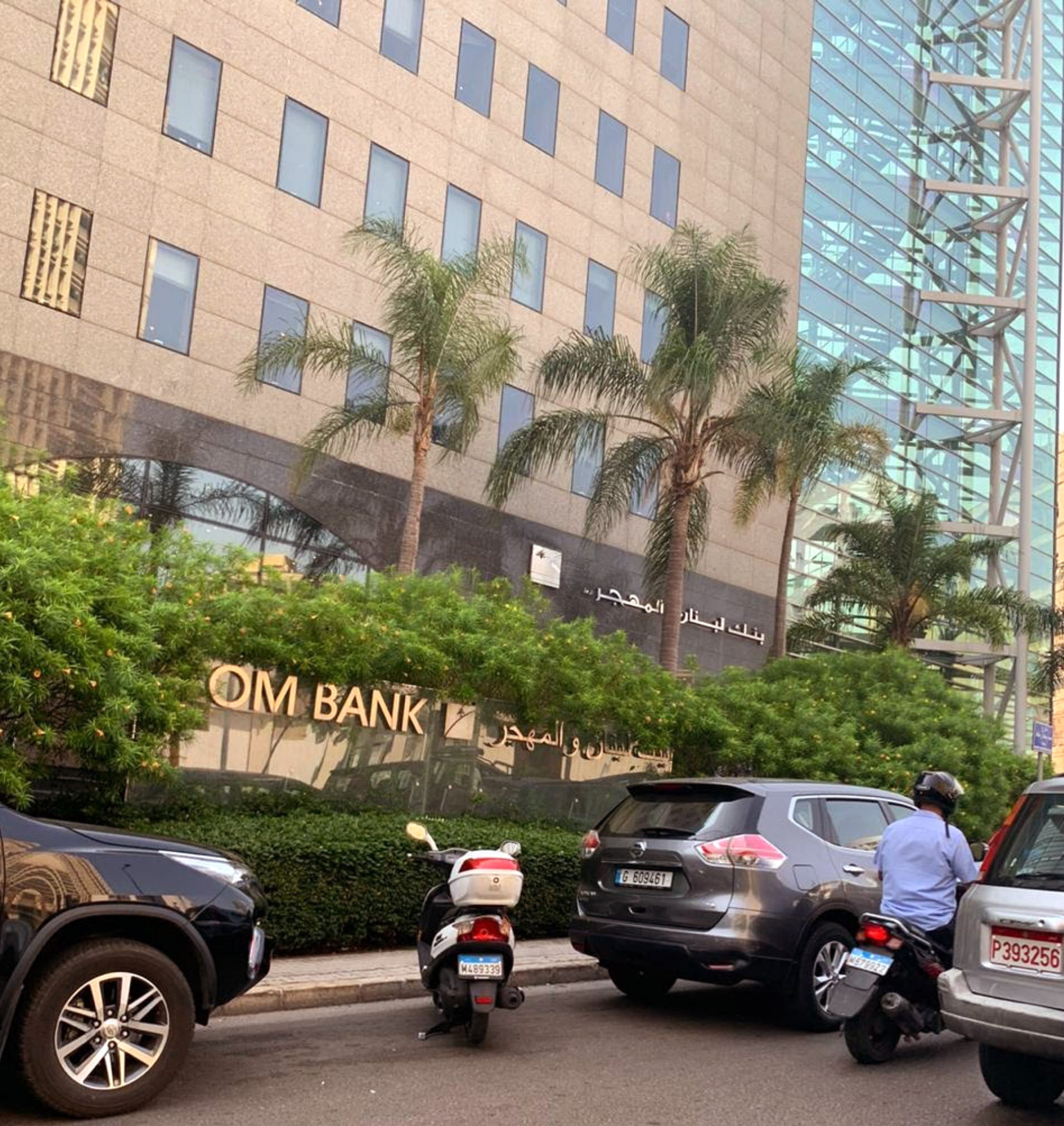
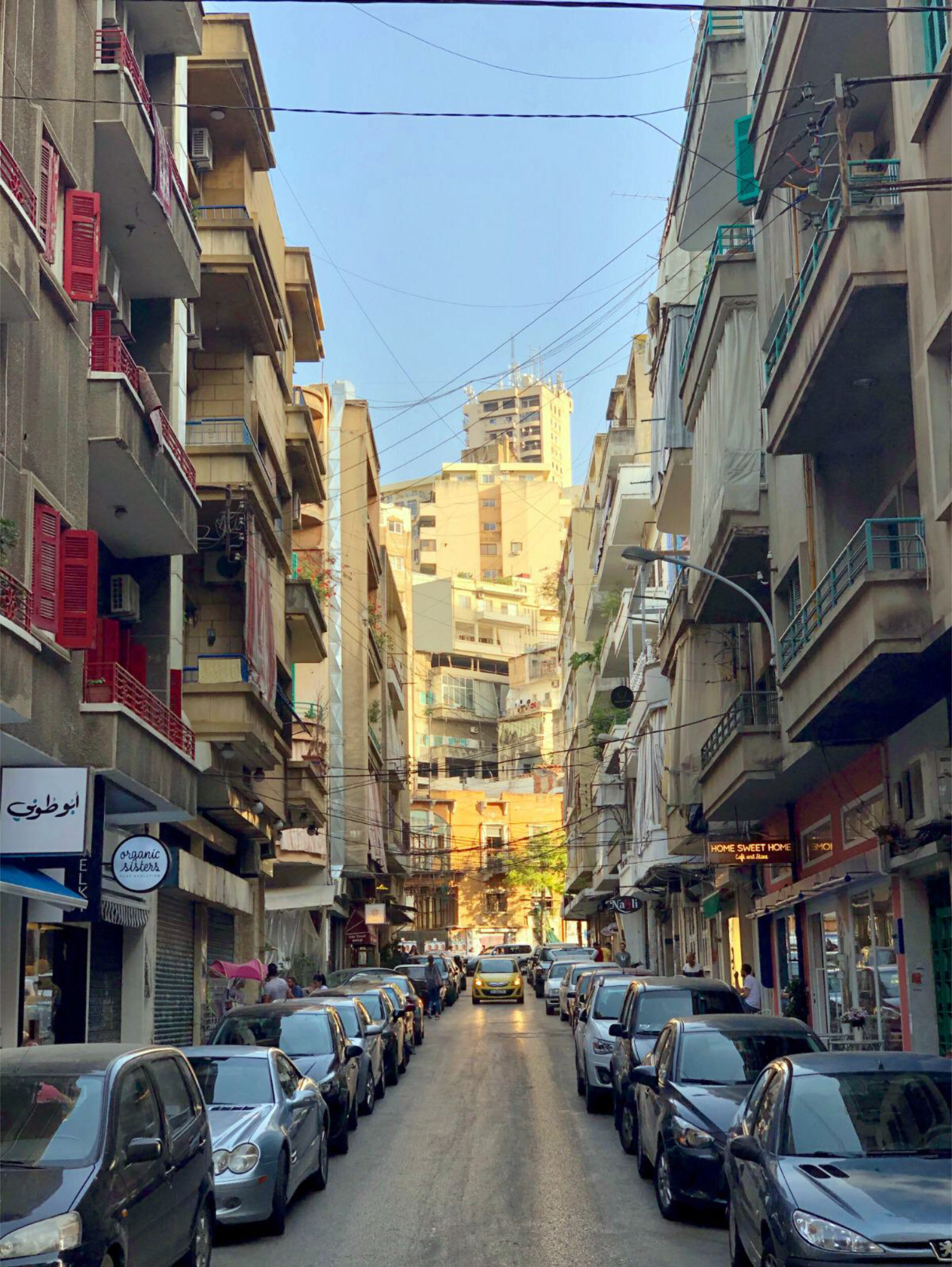
Kellon ya3ne kellon (ALL of them and we mean ALL): the warlords and endlessly recycled politicians leading the Lebanese governments over the years will be difficult to force out not because Hizballah is the mightiest military force of Lebanon (which in its heyday succeeded in defeating the Israeli army and occupation forces, particularly in the South where the Israelis wanted to continue to steal precious water from the Litani River). Nor will the sectarian system be difficult to dismantle because the Christian sects are dwindling in numbers and do not wish to lose protective political control in a secular state with a clear Muslim majority. These fears and power struggles are of course very real. But bringing to an end the sectarian system is in the hands of the people, the younger generations in particular.
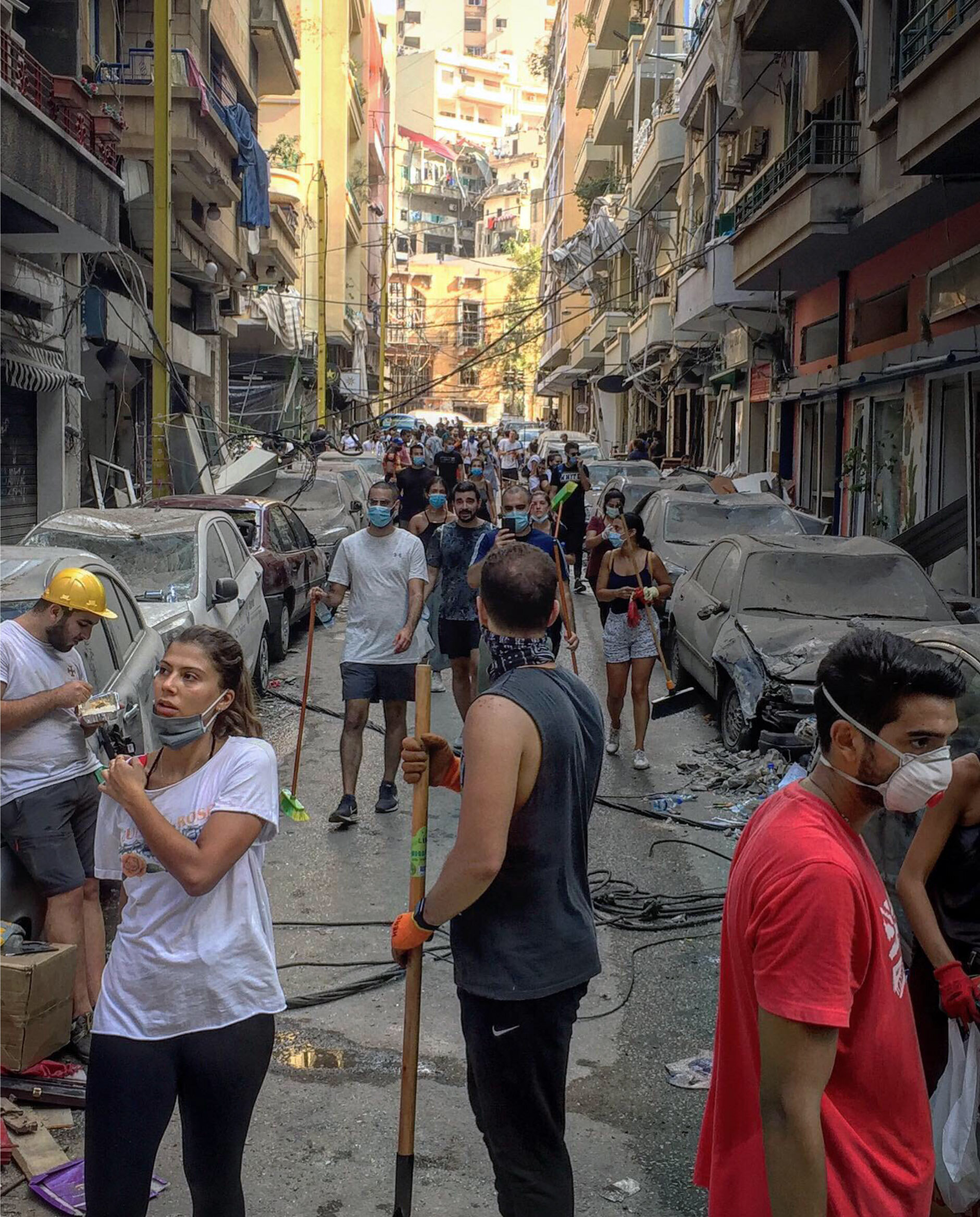
What of course enabled successive governments so criminally corrupt that the center of Beirut is now paved with glass shards and rubble—lives and livelihoods lost, the people traumatized and heart-broken more than ever before, even in a long history of war and loss—is mass consent to sectarian rule. And corruption cannot exist exclusively in the upper echelons of society. What sustains government corruption is social corruption embedded in Lebanon’s “hidden” and vast systems of exploitation and exclusion: foreign indentured servitude and refugees held in captivity. Why include these realities in our understanding of corruption in Lebanon? Indentured servitude is the structural underbelly that creates corrupted families, from rich to lower-middle class (regardless of how well servants are paid or treated, or how much more they make serving Lebanese families than would be possible in their home countries, living with their own families). The problem is structural, an anti-democratic system that corrupts, in domestic spheres, nearly an entire society, reinforcing discriminatory ideas and practices. We cannot build a modern, secular state and sustain such heart-breaking exploitation and exclusion in all of Lebanon, from enormous refugee populations who are denied basic rights (the Palestinians for generations now) to the indentured servants who are abandoned in the streets and in front of the Ethiopian Embassy of Beirut, for example, when families, since in the economic collapse, could no longer pay their salaries. These systems do not simply parallel but support government corruption. And yet the far-reaching impact of these anti-democratic systems are dismissed and ignored, and any criticism of them meets with a deafening silence at best. Much of Lebanese society partakes in this exclusion and exploitation. This is changing in small circles of activists who call for the abolishment of indentured servitude as an important pillar of corruption.
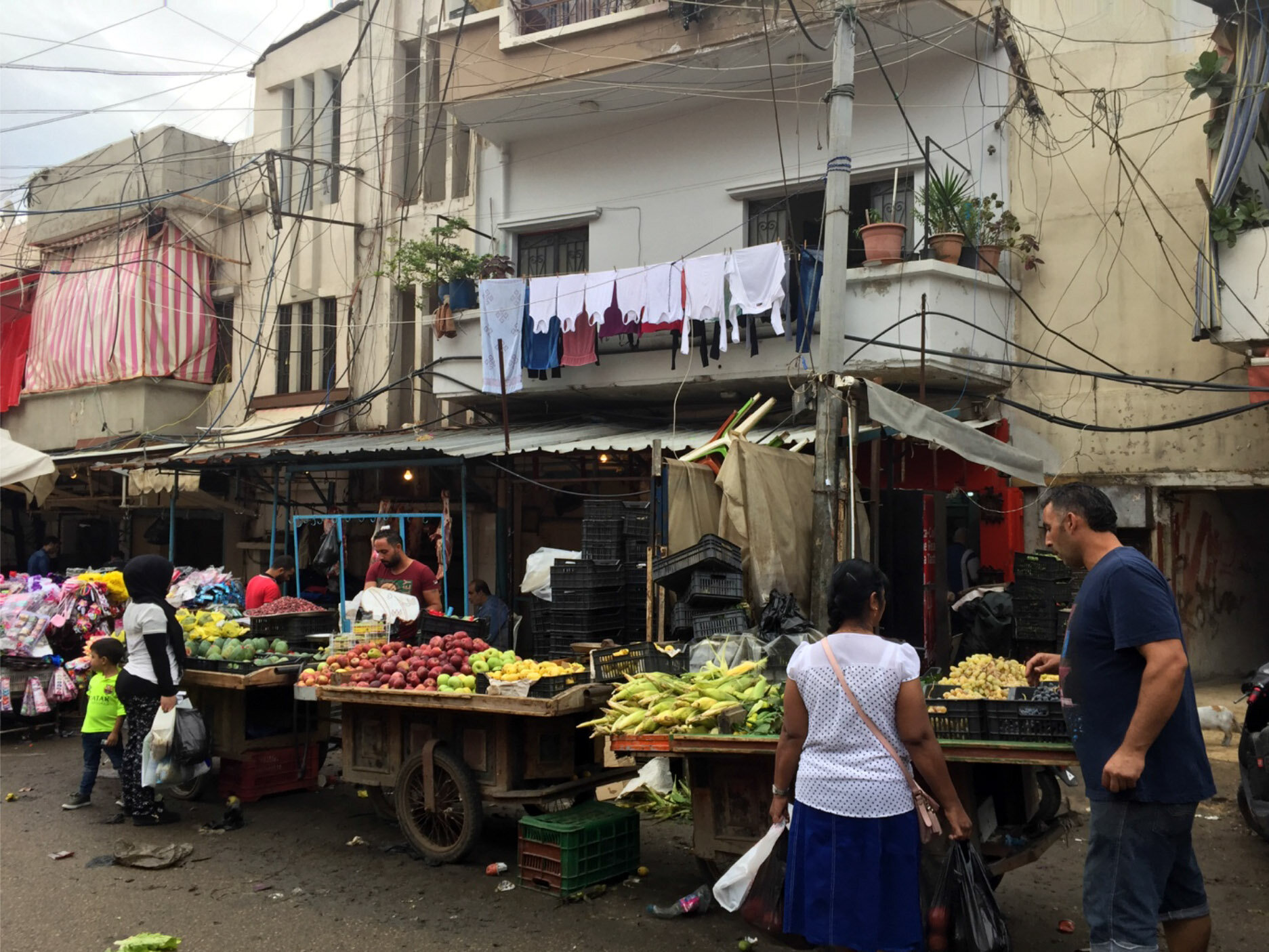
Ideally, leadership positions in a new government should be limited to the street cleaners, repairers, and cooks feeding the people, who have now relaunched the revolution following the 2750 metric tons of aluminum nitrate that all the politicians and warlords in Lebanon left to explode in the heart of Beirut on August 4, 2020. The multitudes of young generations especially who are now cleaning, rebuilding, cooking, and protesting—they are Lebanon’s hope. These are the people that will be less tainted by a belief in the sectarian system and long-standing myth that it enhances stability. Many grew up being served by indentured servants, and they are training themselves in autonomy and freedom, through the labor of repairing their hometown and capital, building community on new terms, imagining a new system of government for Lebanon.
This kind of labor and acts of solidarity train new ways of seeing. Yet this must be accompanied by an honest reckoning with the systems of corruption in domestic life, state denial of refugee integration and rights, as well as women’s legal rights. Corruption is always deep-seated. We do not wish to simply perpetuate such large-scale systems of exploitation and exclusion in a new government. This would defeat the project of a secular, democratic state. The stakes are so very high, and it is crucial that these exploitation and exclusion systems be taken to the streets now. Otherwise Lebanon risks perpetuating corrupt political power and ensuing tragedies. There are more forces that will try to protect the sectarian system as well as corruption. But the revolution is the most important player in the field, and it needs to protest corruption in the kitchen and the government simultaneously. Let us support these remarkable young people all over Lebanon, help them work to fully dismantle these exploitative and corrupt systems, to continue to transform thinking and practice, creating alternative social and political systems and lead the country. As Mandela once reminded us: “It always seems impossible until it’s done.”


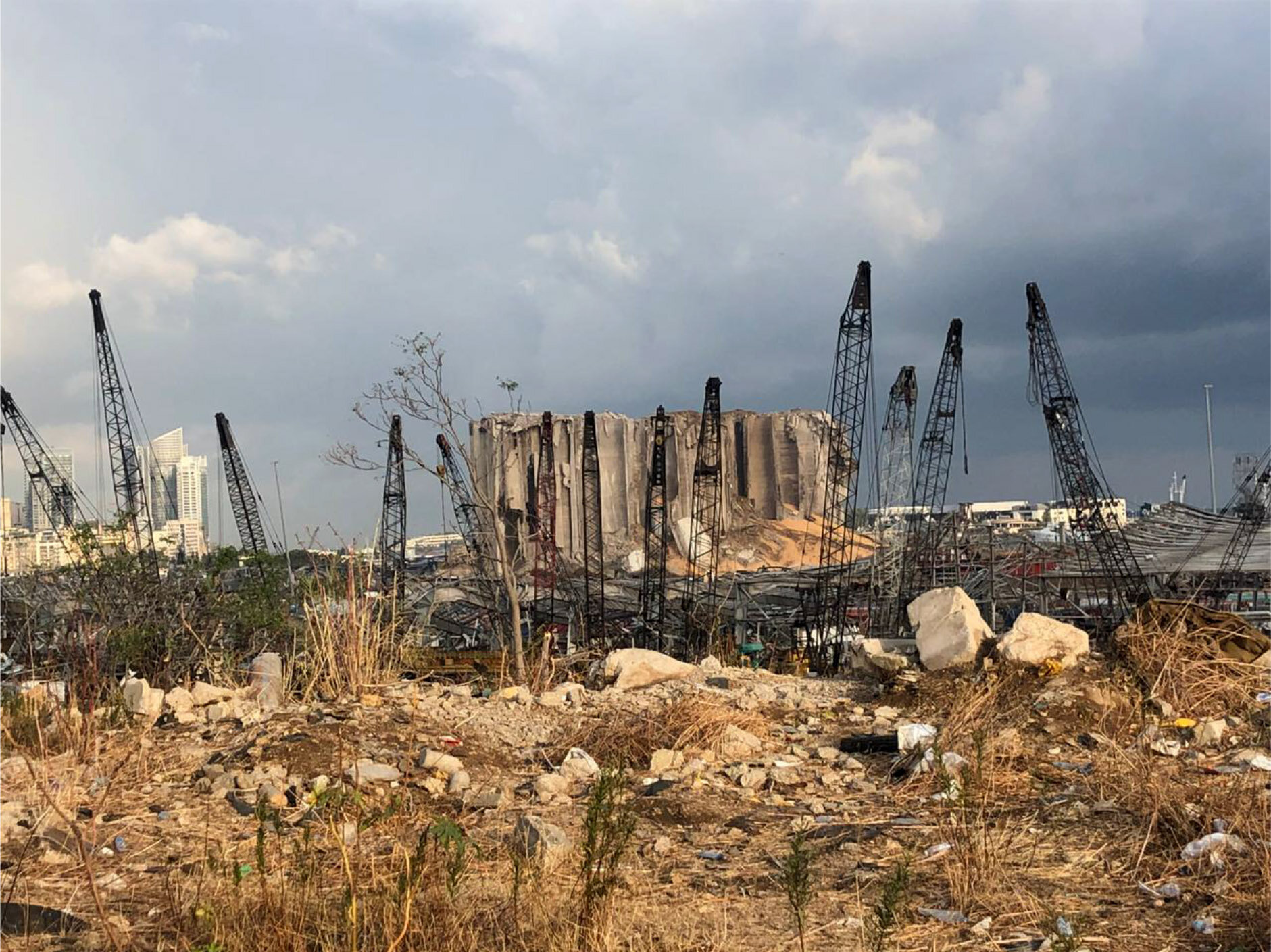
Such a gorgeous, tragic, hopeful piece.
This is a beautiful essay of brief glimpses long remembered, and of enduring memories of the city sifted, re-sifted, recurring and revolving. It’s use of photographs as portals to these lengthening glimpses is critically astute, and it’s observations and intimations of revolution are full of poignant possibility. I loved reading it. I will teach it in my course on photography and memory as soon as I am able. What a pleasure and deep instruction.
Beautifully written piece about an indescribable city we all love to love, hate and be frustrated with! Beirut through the years in the eyes of someone who intimately understands its nuances.
I was thoroughly captivated by this contemplative, lyrical and trenchant reflection on our impossible Beirut. There is so much here to learn from, to teach and to debate. Thank you for this generous and beautifully written piece.
مقال رائع.. شعرت وكأني شاهد عيان